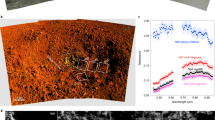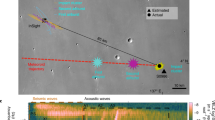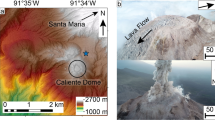Abstract
Random bombardment by comets, asteroids and associated fragments form and alter the lunar regolith and other rocky surfaces. The accumulation of impact craters over time is of fundamental use in evaluating the relative ages of geologic units. Crater counts and radiometric ages from returned samples provide constraints with which to derive absolute model ages for unsampled units on the Moon and other Solar System objects1,2,3,4. However, although studies of existing craters and returned samples offer insight into the process of crater formation and the past cratering rate, questions still remain about the present rate of crater production, the effect of early-stage jetting during impacts and the influence that distal ejecta have on the regolith. Here we use Lunar Reconnaissance Orbiter Camera (LROC) Narrow Angle Camera (NAC) temporal (‘before and after’) image pairs to quantify the contemporary rate of crater production on the Moon, to reveal previously unknown details of impact-induced jetting, and to identify a secondary impact process that is rapidly churning the regolith. From this temporal dataset, we detected 222 new impact craters and found 33 per cent more craters (with diameters of at least ten metres) than predicted by the standard Neukum production and chronology functions for the Moon2. We identified broad reflectance zones associated with the new craters that we interpret as evidence of a surface-bound jetting process. We also observe a secondary cratering process that we estimate churns the top two centimetres of regolith on a timescale of 81,000 years—more than a hundred times faster than previous models estimated from meteoritic impacts (ten million years)5.
This is a preview of subscription content, access via your institution
Access options
Subscribe to this journal
Receive 51 print issues and online access
$199.00 per year
only $3.90 per issue
Buy this article
- Purchase on Springer Link
- Instant access to full article PDF
Prices may be subject to local taxes which are calculated during checkout




Similar content being viewed by others
References
Ivanov, B. A. in Chronology and Evolution of Mars (eds Kallenbach, R. et al.) 87–104 (Springer, 2001)
Neukum, G., Ivanov, B. A. & Hartmann, W. K. Cratering records in the inner Solar System in relation to the lunar reference system. Space Sci. Rev. 96, 55–86 (2001)
Hartmann, W. K. Martian cratering 8: isochron refinement and the chronology of Mars. Icarus 174, 294–320 (2005)
Stöffler, D. & Ryder, G. Stratigraphy and isotope ages of lunar geologic units: chronological standard for the inner Solar System. Space Sci. Rev. 96, 9–54 (2001)
Gault, D. E., Hörz, F., Brownlee, D. E. & Hartung, J. B. Mixing of the lunar regolith. In Proc. Lunar Sci. Conf. 5th Vol. 3 (ed. Gose, W. A ) 2365–2386 (Lunar and Planetary Institute, 1974)
Daubar, I. J. et al. New craters on Mars and the Moon. Lunar Planet. Sci. Conf. 42, abstr. 2232 (2011)
Robinson, M. S. et al. New crater on the Moon and a swarm of secondaries. Icarus 252, 229–235 (2015)
Suggs, R. M., Moser, D. E., Cooke, W. J. & Suggs, R. J. The flux of kilogram-sized meteoroids from lunar impact monitoring. Icarus 238, 23–36 (2014)
Madiedo, J. M., Ortiz, J. L., Morales, N. & Cabrera-Cano, J. A large lunar impact blast on 2013 September 11. Mon. Not. R. Astron. Soc. 439, 2364–2369 (2014)
Michael, G. G., Kneissl, T. & Neesemann, A. Planetary surface dating from crater size–frequency distribution measurements: Poisson timing analysis. Icarus 277, 279–285 (2016)
Le Feuvre, M. & Wieczorek, M. A. Nonuniform cratering of the Moon and a revised crater chronology of the inner Solar System. Icarus 214, 1–20 (2011)
Shoemaker, E. M. in Physics and Astronomy of the Moon (ed. Kopal, Z. ) 283–357 (Academic Press, 1963)
Melosh, H. J. Impact Cratering: A Geologic Process (Oxford Univ. Press, 1989)
Oberbeck, V. R. The role of ballistic erosion and sedimentation in lunar stratigraphy. Rev. Geophys. Space Phys. 13, 337–362 (1975)
Johnson, B. C., Bowling, T. J. & Melosh, H. J. Jetting during vertical impacts of spherical projectiles. Icarus 238, 13–22 (2014)
Hapke, B. & van Hoen, H. Photometric studies of complex surfaces, with applications to the Moon. J. Geophys. Res. 68, 4545–4570 (1963)
Hapke, B. Bidirectional reflectance spectroscopy. Icarus 195, 918–926 (2008)
Veverka, J. in Physical Studies of Minor Planets NASA SP-267 (ed. Gehrels, T. ) 79–90 (NASA, 1971)
Bandfield, J. L. et al. Lunar cold spots: granular flow features and extensive insulating materials surrounding young craters. Icarus 231, 221–231 (2014)
Vickery, A. M. The theory of jetting: application to the origin of tektites. Icarus 105, 441–453 (1993)
Melosh, H. J. & Sonett, C. P. When worlds collide: jetted vapor plumes and the Moon’s origin. In Origins of the Moon Proc. Conf. (eds Hartmann, W. K. et al. .) 621–642 (Lunar and Planetary Institute, 1986)
Clegg, R. N., Jolliff, B. L., Robinson, M. S., Hapke, B. W. & Plescia, J. B. Effects of rocket exhaust on lunar soil reflectance properties. Icarus 227, 176–194 (2014)
Clegg-Watkins, R. N. et al. Photometric characterization of the Chang’e-3 landing site using LROC NAC images. Icarus 273, 84–95 (2016)
Shkuratov, Y., Kaydash, V., Sysolyatina, X., Razim, A. & Videen, G. Lunar surface traces of engine jets of Soviet sample return probes: the enigma of the Luna-23 and Luna-24 landing sites. Planet. Space Sci. 75, 28–36 (2013)
Schultz, P. H. & Gault, D. E. Clustered impacts: experiments and implications. J. Geophys. Res. 90, 3701–3732 (1985)
Swann, G. A. et al. Geology of the Apollo 14 Landing Site in the Fra Mauro Highlands. Professional Paper 880 (US Geological Survey, 1977)
McKay, D. S. et al. . in Lunar Sourcebook (eds Heiken, G. H. et al.) 285–356 (Cambridge Univ. Press, 1991)
Fruchter, J. S., Rancitelli, L. A. & Perkins, R. W. Recent and long-term mixing of the lunar regolith based on 22Na and 26Al measurements in Apollo 15, 16, and 17 deep drill stems and drive tubes. In Proc. Lunar Sci. Conf. 7th Vol. 1 (ed. Merrill, R. B. ) 27–39 (Lunar Planetary Institute, 1976)
Fruchter, J. S., Rancitelli, L. A., Laul, J. C. & Perkins, R. W. Lunar regolith dynamics based on analysis of the cosmogenic radionuclides 22Na, 26Al, and 53Mn. In Proc. Lunar Sci. Conf. 8th Vol. 3 (ed. Merrill, R. B. ) 3595–3605 (Lunar Planetary Institute, 1977)
Fruchter, J. S., Rancitelli, L. A., Evans, J. C. & Perkins, R. W. Lunar surface processes and cosmic ray histories over the past several million years. In Proc. Lunar Sci. Conf. 9th Vol. 2 (ed. Merrill, R. B. ) 2019–2032 (Lunar Planetary Institute, 1978)
Robinson, M. S. et al. Lunar Reconnaissance Orbiter Camera (LROC) instrument overview. Space Sci. Rev. 150, 81–124 (2010)
Thompson, S. D., Bowles, Z. R., Povilaitis, R. Z., Daubar, I. J. & Robinson, M. S. Recent impacts on the Moon. 45th Lunar and Planet. Sci. Conf. abstr. 2769 (2014)
Speyerer, E. J. J. et al. Pre-flight and on-orbit geometric calibration of the lunar reconnaissance orbiter camera. Space Sci. Rev. 200, 357–392 (2016)
Anderson, J. A., Sides, S. C., Soltesz, D. L., Sucharski, T. L. & Becker, K. J. Modernization of the Integrated Software for Imagers and Spectrometers. Lunar Planet. Sci. Conf. 35, abstr. 2039 (2004)
Gonzalez, R. C. & Woods, R. E. Digital Image Processing (Addison-Wesley, 1992)
Daubar, I. J., McEwen, A. S., Byrne, S., Kennedy, M. R. & Ivanov, B. The current martian cratering rate. Icarus 225, 506–516 (2013)
Marchi, S., Mottola, S., Cremonese, G., Massironi, M. & Martellato, E. A new chronology for the Moon and Mercury. Astron. J. 137, 4936–4948 (2009)
Ivanov, B. A. Earth/Moon impact rate comparison: searching constraints for lunar secondary/primary cratering proportion. Icarus 183, 504–507 (2006)
Brown, P. G. et al. A 500-kiloton airburst over Chelyabinsk and an enhanced hazard from small impactors. Nature 503, 238–241 (2013)
Daubar, I. J. et al. Changes in blast zone albedo patterns around new martian impact craters. Icarus 267, 86–105 (2016)
Acknowledgements
We acknowledge the engineers and technical support team at NASA Goddard Space Flight Center and Arizona State University who enable the collection of a vast image archive of the lunar surface that will be used for decades to come. This work is supported by the Lunar Reconnaissance Orbiter (LRO) Project and the Arizona State University LROC contract.
Author information
Authors and Affiliations
Contributions
E.J.S. drafted the manuscript and authored the CRISP software used to identify surface changes. R.Z.P. classified and catalogued the temporal changes. M.S.R. is the principal investigator for the Lunar Reconnaissance Orbiter Camera and provided key contributions to the scientific interpretations. P.C.T. aided in the scientific interpretations of splotches and reflectance zones. R.V.W. assisted in optimizing the change detection software and assessed temporal changes. All of the authors contributed to interpretation and analysis of the data.
Corresponding author
Ethics declarations
Competing interests
The authors declare no competing financial interests.
Additional information
Reviewer Information Nature thanks M. Cintala, B. Ivanov and the other anonymous reviewer(s) for their contribution to the peer review of this work.
Extended data figures and tables
Extended Data Figure 1 Reflectance changes caused by emplacement of splotches.
Histogram of reflectance changes associated with low-reflectance (top; n = 18,756) and high-reflectance (bottom; n = 1,757) splotches.
Extended Data Figure 2 Distribution of NAC temporal pairs.
Image footprints colour-coded by the number of days between the before and after observations (June 2009 to May 2015). The size of image footprints are exaggerated for display clarity.
Extended Data Figure 3 Temporal-pair statistics.
Left, distribution of the area covered by individual temporal pairs versus the temporal spacing between the corresponding observations. Right, histogram of the ground sampling distance for each after image of the NAC temporal pair.
Extended Data Figure 4 Effect of image registration errors.
a–d, Examples of a temporal ratio image with decreasing pixel offsets (ratio of NAC frames M188678240LR/M1180548227LR): 10-pixel offset (7.8-m offset; a); 5-pixel offset (3.9-m offset; b); 3-pixel offset (2.3-m offset; c); and <1-pixel offset (<0.8-m offset; d). The larger offsets in a–c make the identification of the new impact crater impossible.
Extended Data Figure 5 R-plot of new crater population.
Relative crater frequency R of the 222 new impact craters identified with temporal imaging. For reference, a 1-yr isochron (grey line) derived from the NPF is overlaid for diameters of ≥10 m. Error bars are estimated on the basis of Poisson statistics of counts.
Extended Data Figure 6 Details of the impact process recorded in the temporal pair.
Temporal ratio image of the 17 March 2013 impact site surrounded by four distinct reflectance zones (ratio of NAC frames M1129645568L/M183689789L).
Extended Data Figure 7 Range of reflectance zones associated with new impacts.
Maximum zone distance versus crater diameter for each of the four reflectance zones observed around new impacts. Craters smaller than 3 m in diameter were excluded from the least-squares fit.
Rights and permissions
About this article
Cite this article
Speyerer, E., Povilaitis, R., Robinson, M. et al. Quantifying crater production and regolith overturn on the Moon with temporal imaging. Nature 538, 215–218 (2016). https://doi.org/10.1038/nature19829
Received:
Accepted:
Published:
Issue Date:
DOI: https://doi.org/10.1038/nature19829
This article is cited by
-
Automated Lunar Crater Identification with Chandrayaan-2 TMC-2 Images using Deep Convolutional Neural Networks
Scientific Reports (2024)
-
Dark spots on Mercury show no signs of weathering during 30 Earth months
Communications Earth & Environment (2022)
-
The Exosphere as a Boundary: Origin and Evolution of Airless Bodies in the Inner Solar System and Beyond Including Planets with Silicate Atmospheres
Space Science Reviews (2022)
-
Two-billion-year-old volcanism on the Moon from Chang’e-5 basalts
Nature (2021)
-
Impactor material records the ancient lunar magnetic field in antipodal anomalies
Nature Communications (2021)
Comments
By submitting a comment you agree to abide by our Terms and Community Guidelines. If you find something abusive or that does not comply with our terms or guidelines please flag it as inappropriate.



